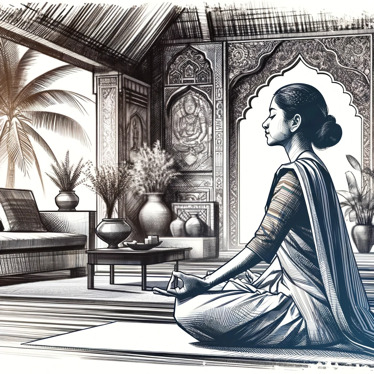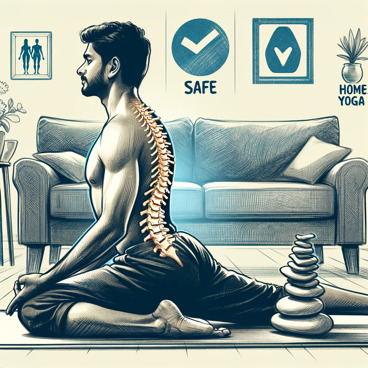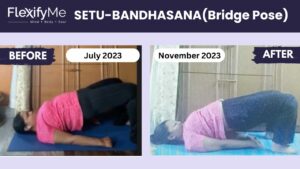Imagine waking up each day with the shadow of back pain cast by bulging discs. For many, this is not just a scenario but a daily reality. In a world where invasive procedures and heavy medication often take center stage in treatment plans, there emerges a gentle yet powerful ally: yoga. Practicing yoga from the comfort of home opens up a realm of possibilities for those seeking non-surgical pain management for bulging discs.
The journey of managing spinal health issues like bulging discs can be fraught with challenges and uncertainties. While conventional treatments have their place, the allure of a more natural and holistic path to wellness is undeniable. This is where yoga, an ancient practice rooted in the harmony of body and mind, steps in as a beacon of hope. It offers not just physical relief but a holistic approach to managing the complexities of spinal health.
In this guide, we delve into the heart of yoga’s healing powers, specifically tailored to aid those suffering from the discomfort of bulging discs. We unravel the myths, illuminate the facts, and provide practical insights into how yoga, when practiced correctly at home, can be a transformative experience. This isn’t just about temporary relief; it’s about embarking on a journey towards lasting spinal health and well-being.
As we traverse through the nuances of yoga for bulging discs, you’ll discover that this ancient art form is more than just a series of poses. It’s a pathway to regain control over your body, to soothe the aches that have become all too familiar, and to reclaim the quality of life often overshadowed by pain.
So, whether you’re a seasoned yoga enthusiast or a newcomer to this practice, this guide is your first step towards understanding how yoga can be a powerful tool in your arsenal against bulging discs. Let’s embark on this journey together, exploring how the practice of yoga at home can be a transformative step in managing your spinal health.
Demystifying Bulging Discs: Causes, Symptoms, and Impact
In the journey to manage bulging discs through yoga, comprehending the condition itself is crucial. Often masked behind general back pain, bulging discs are more than just an occasional discomfort; they represent a significant disruption in spinal health, affecting lives in more ways than one.
The Anatomy of a Bulging Disc
Imagine the spine as a stack of bones, known as vertebrae, with shock-absorbing discs between them. A bulging disc occurs when one of these discs, due to strain or age, extends beyond its usual boundary. This protrusion, albeit less severe than a herniated disc, can still press against spinal nerves, leading to discomfort or pain.
Triggers and Symptoms
Why do bulging discs occur? The reasons vary, spanning from natural aging to lifestyle factors like poor posture, repetitive strain, or even an injury. The symptoms, however, follow a common thread – localized pain, numbness, or a tingling sensation that can radiate to other parts of the body, depending on the affected nerve.
The Ripple Effect on Daily Life
The impact of bulging discs extends beyond physical pain. It can be a hurdle in daily activities, a deterrent to an active lifestyle, and in some cases, a contributor to mental stress. The chronic nature of this condition often necessitates a long-term management strategy, where quick fixes are less effective than sustainable approaches.
Setting the Stage for Yoga’s Role
In understanding the nature and consequences of bulging discs, we lay the foundation for exploring yoga as a viable, non-surgical solution. This section serves as a prelude to how specific yoga practices can align with the needs and challenges posed by bulging discs, offering a ray of hope for those seeking relief and a return to normalcy.
As we move forward, keep in mind that knowledge is the first step towards empowerment. With a deeper understanding of what bulging discs entail, you are better equipped to embark on the healing journey that yoga promises, a journey that aligns the body, mind, and spirit in the pursuit of spinal health and overall well-being.
Yoga’s Healing Embrace: A Soothing Balm for Bulging Discs
Embarking on the path of yoga for spinal health unveils a world where gentle stretches and mindful breathing harmonize to bring solace to those suffering from bulging discs. This ancient practice, steeped in tradition and healing, offers more than temporary relief; it serves as a cornerstone in the journey towards a healthier spine and a more balanced life.
Yoga: A Blend of Strength and Flexibility
Yoga’s power in managing bulging disc pain lies in its unique combination of strengthening and stretching exercises. These movements encourage spinal alignment, crucial in alleviating the pressure on bulging discs. Regular practice helps in fortifying the muscles around the spine, providing better support and reducing the likelihood of further disc displacement.
The Role of Breathing and Mindfulness
The benefits of yoga transcend physical aspects; its breathing techniques and mindfulness practices play a pivotal role. Deep, controlled breathing during yoga not only enhances relaxation but also helps in managing pain more effectively. The meditative elements of yoga foster a mental resilience that is invaluable in coping with the chronic nature of spinal issues.
Addressing Pain and Improving Mobility
For many grappling with the discomfort of bulging discs, yoga has been a gateway to improved mobility and reduced pain. Its gentle yet effective approach offers a stark contrast to more invasive treatments, aligning with the body’s natural healing process. Through consistent practice, yoga can help in gradually restoring the range of motion, often restricted by bulging disc pain.
A Holistic Approach to Spinal Health
Yoga’s holistic approach addresses not just the physical symptoms of bulging discs but also the emotional and mental challenges that accompany them. This comprehensive management strategy is key in not just combating pain but also in improving overall quality of life.
As we delve deeper into yoga’s therapeutic realm, it’s important to remember that each journey is unique. The subsequent sections will guide you through safe and effective yoga practices specifically designed for those with bulging discs, paving the way towards a future where spinal health is nurtured and cherished.
In the quiet corners of our homes lies the potential to create a sanctuary for healing and rejuvenation, especially for those navigating the challenges of bulging discs. This section is dedicated to guiding you through establishing a safe and effective home yoga practice, ensuring that each stretch and pose contributes positively to your spinal health.
Setting the Stage for Safety and Comfort
Before embarking on yoga exercises, the importance of creating a safe environment cannot be overstated. Choose a calm, comfortable space in your home, free from distractions. Investing in a good yoga mat and possibly a few props like blocks or a bolster can make a significant difference in your practice, especially when dealing with sensitive conditions like bulging discs.
Yoga Poses: Gentle and Gradual
When it comes to selecting yoga poses, the key is to start gently and progress gradually. Focus on poses that encourage spinal alignment and core strength without exerting pressure on the affected areas. Examples include the Cat-Cow stretch for flexibility, the Child’s Pose for relaxation, and the Sphinx Pose for gentle back extension. Remember, the goal is not to push into pain but to move within a comfortable range.

Listening to Your Body: The Ultimate Guide
As you move through each pose, stay attuned to your body’s signals. Pain is a clear indicator to stop and readjust. It’s crucial to approach yoga with patience and mindfulness, especially when dealing with a condition like bulging discs that can flare up with improper movement.
Incorporating Breathing and Mindfulness
Integrate deep, mindful breathing into your practice. This not only enhances relaxation and stress relief but also helps in managing pain more effectively. End each session with a few minutes of meditation or relaxation to allow the body to assimilate the benefits of your practice.
A Journey of Discovery and Healing
Home yoga practice for bulging disc management is a journey of self-discovery and healing. Each session is an opportunity to learn more about your body and its capabilities. As you progress, you’ll find your practice not only alleviating pain but also imbuing a sense of overall well-being.
As we draw our exploration to a close, it’s important to reflect on the journey we’ve embarked upon. Yoga, a practice rich in history and healing, offers more than just physical benefits; it’s a pathway to a life less defined by the pain and limitations of bulging discs. In the comfort of your home, you can harness yoga’s power to not only manage but also transform your experience with this condition.
A Personal Commitment to Health
The journey of using yoga for bulging disc management is deeply personal and immensely rewarding. It requires a commitment to regular practice and a willingness to listen to your body’s needs. As you incorporate yoga into your daily routine, you’ll likely notice improvements not just in your spinal health but in your overall well-being.
Your Next Steps
If you’re standing at the threshold, wondering whether to step into the world of yoga, let this be your gentle nudge forward. Start with the simple poses and breathing exercises we’ve discussed, and gradually build up your practice. Remember, every journey begins with a single step, and every pose is a move towards a healthier spine.
A Call to Empowerment
As you embark on this path, know that you’re not just managing symptoms; you’re embracing a holistic approach to health that benefits your entire being. Yoga offers a way to live in harmony with your body, even amidst challenges like bulging discs.

Your Journey Awaits
So, let this conclusion be a beginning. A beginning of your journey towards healing, strength, and flexibility. The path of yoga is open to you, inviting you to explore its depths and reap its benefits. Take this step today, for your spine, for your health, for you.
Frequently Asked Questions
What benefits does meditation offer for managing stress and improving sleep?
FlexifyMe's meditation sessions are crafted to aid in stress relief and enhance sleep quality, forming an integral part of our comprehensive wellness programs.
Can FlexifyMe help with weight loss through yoga?
Yes, our programs include yoga for weight loss, combining physical postures, breathing techniques, and meditation to help you achieve your fitness goals in a holistic manner.
Are FlexifyMe's yoga and meditation programs suitable for beginners?
Absolutely, we offer yoga for beginners and meditation guidance that's customized to your pace and starting level, ensuring a supportive and effective introduction to wellness.
How do FlexifyMe's corporate wellness programs benefit employees?
Our corporate wellness programs are designed to promote health and fitness in the workplace, offering online yoga classes and meditation sessions that fit into busy schedules and support overall employee well-being.
What kind of personalized yoga instruction does FlexifyMe provide?
Our personalized yoga instruction is tailored to individual health and wellness goals, ensuring you receive one-on-one guidance that caters to your specific needs, whether it's for fitness, stress relief, or prenatal care.
How does FlexifyMe accommodate prenatal yoga needs?
We offer specialized prenatal yoga sessions that focus on gentle poses and breathing techniques to support health and wellness throughout pregnancy.
What differentiates FlexifyMe's approach to wellness and fitness?
FlexifyMe's holistic approach combines yoga, meditation, and nutrition advice, offering a rounded path to health and fitness that adapts to your lifestyle and personal goals.
Can FlexifyMe's online yoga classes be scheduled around my busy lifestyle?
Yes, our online yoga classes offer flexible scheduling options to seamlessly integrate into your lifestyle, ensuring you can maintain your fitness and wellness routine without hassle.
Does FlexifyMe offer any specialized programs for stress relief?
Our wellness programs include specialized yoga and meditation sessions focused on stress relief, designed to help you manage anxiety and improve your overall health.


